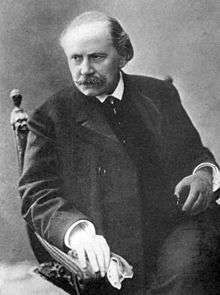Cléopâtre
| Jules Massenet |
|---|
 |
|
Operas
|
|
Oratorios
|
|
Ballets
|
Cléopâtre is an opera in four acts by Jules Massenet to a French libretto by Louis Payen. It was first performed at the Opéra Monte-Carlo on 23 February 1914, nearly two years after Massenet's death.
Cléopâtre is one of three operas by Massenet to be premiered posthumously; the others are Panurge (1913) and Amadis (1922). The piece has seen limited revival since its premiere and has a modest modern recording history.
Performance history
Though the opera was written for the mezzo Lucy Arbell, the role of Cléopâtre was created by the soprano Maria Nikolaevna Kuznetsova. The first American performance took place in Chicago on 10 January 1916 with Kuznetsova. The first New York performance was on 23 January 1919 with Mary Garden. It was revived at the Massenet Festival in Saint-Étienne in 1990 with Kathryn Harries in the title role. This production yielded a live recording (Koch Schwann). In 2004, a concert version was performed at the Liceu in Barcelona with Montserrat Caballé. A concert performance conducted by Vladimir Fedoseyev as part of the Salzburg Whitsun Festival 2012 featured Sophie Koch in the title role, Ludovic Tézier as Marc-Antoine and Véronique Gens as Octavie.[1]
Roles
| Role | Voice type | Premiere Cast,[2][3] 23 February 1914 (Conductor: Léon Jehin) |
|---|---|---|
| Cléopâtre | mezzo-soprano | Maria Nikolaevna Kuznetsova |
| Marc-Antoine | baritone | Alfred Maguénat |
| Octavie | soprano | Lilian Grenville |
| Spakos | tenor | Charles Rousselière |
| Amnhès | baritone | Pierre Clauzure |
| Charmion | soprano | Carton |
| Ennius | baritone | Feiner |
| Sévérus | baritone | Ghastau |
| L'Esclave de la Porte | baritone | Gasparini |
| Adamos | male dancer | Magliani |
| A voice | baritone | Lozé |
| Octave | mute | |
| Chorus: Roman chiefs and soldiers, Greek and Egyptian slaves, nuptial train, crowd in the tavern, Cléopâtre's followers; Dancers - slaves, Lydiennes, Chaldiennes, Phyrigieens, Amazons, Scythians, tavern jugglers. | ||
Synopsis
The story concerns the ill-fated love of Cléopâtre and Marc-Antoine. Marc-Antoine sees Cléopâtre for the first time following the conquering of Egypt and is instantly entranced by her beauty. Dismissing his obligations in Rome, Marc-Antoine goes with Cléopâtre, and even after returning to fulfill his promise of marriage to Octavia, he is lured back by lust and jealousy. Being told, falsely, that Cléopâtre has been killed, Marc-Antoine falls on his own sword and is then brought to Cléopâtre. As she watches him die by her side, she pulls a poisonous snake from a basket of fruit and clutches it to her breast.
Noted arias
- Act 3 - Cléopâtre: "J'ai versé le poison dans cette coupe d'or"
References
Notes
- ↑ Cleopatra – Im Labyrinth von Eros und Macht : Salzburger Pfingsfestspiele accessed 10 August 2014.
- ↑ IMSLP Heugel 1914 vocal score
- ↑ Casaglia, Gherardo (2005).[http://www.amadeusonline.net/almanacco?r=&alm_giorno=23&alm_mese=02&alm_anno=1914&alm_testo=Cl%E9op%E2tre "Cléopâtre, 23 February 1914"]. Almanacco Amadeus (Italian).